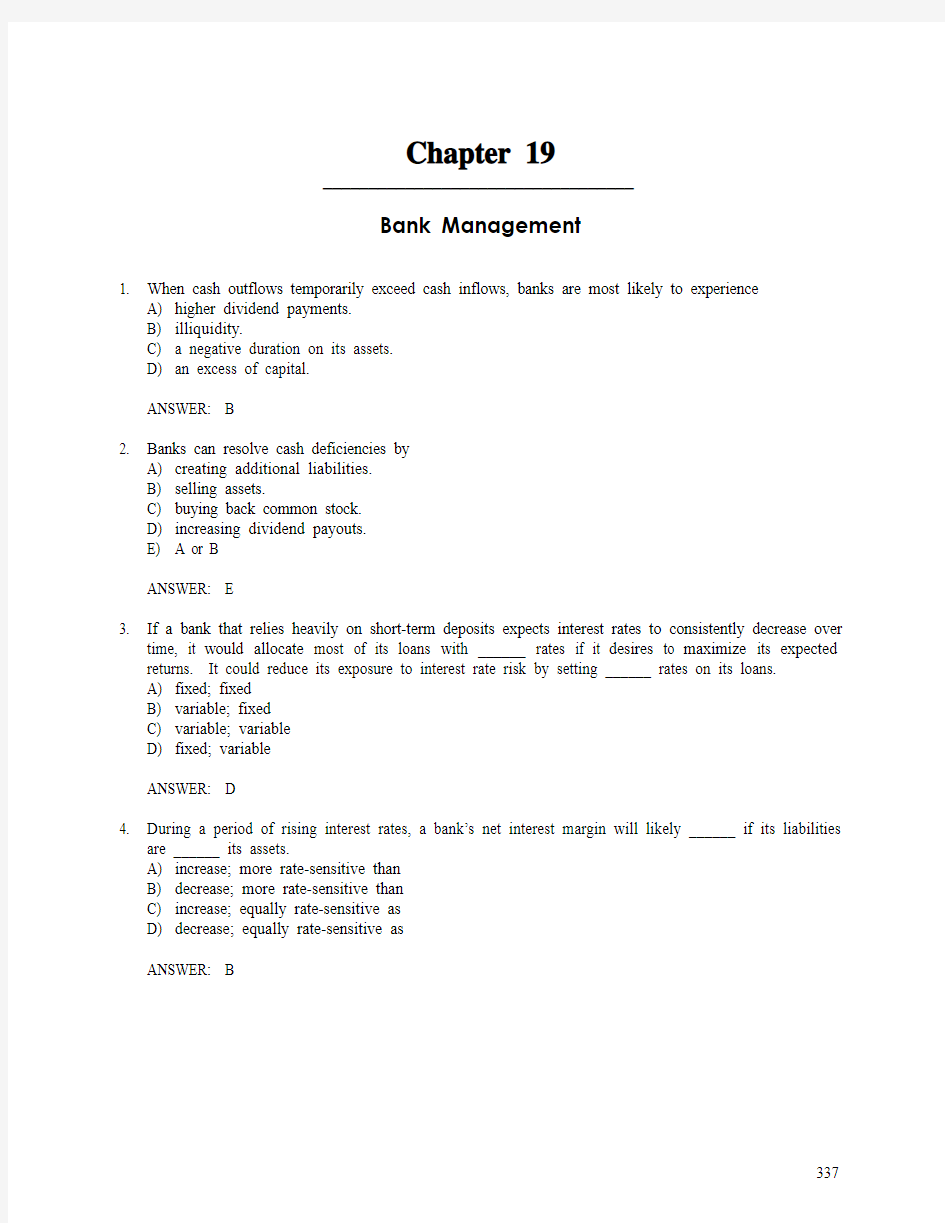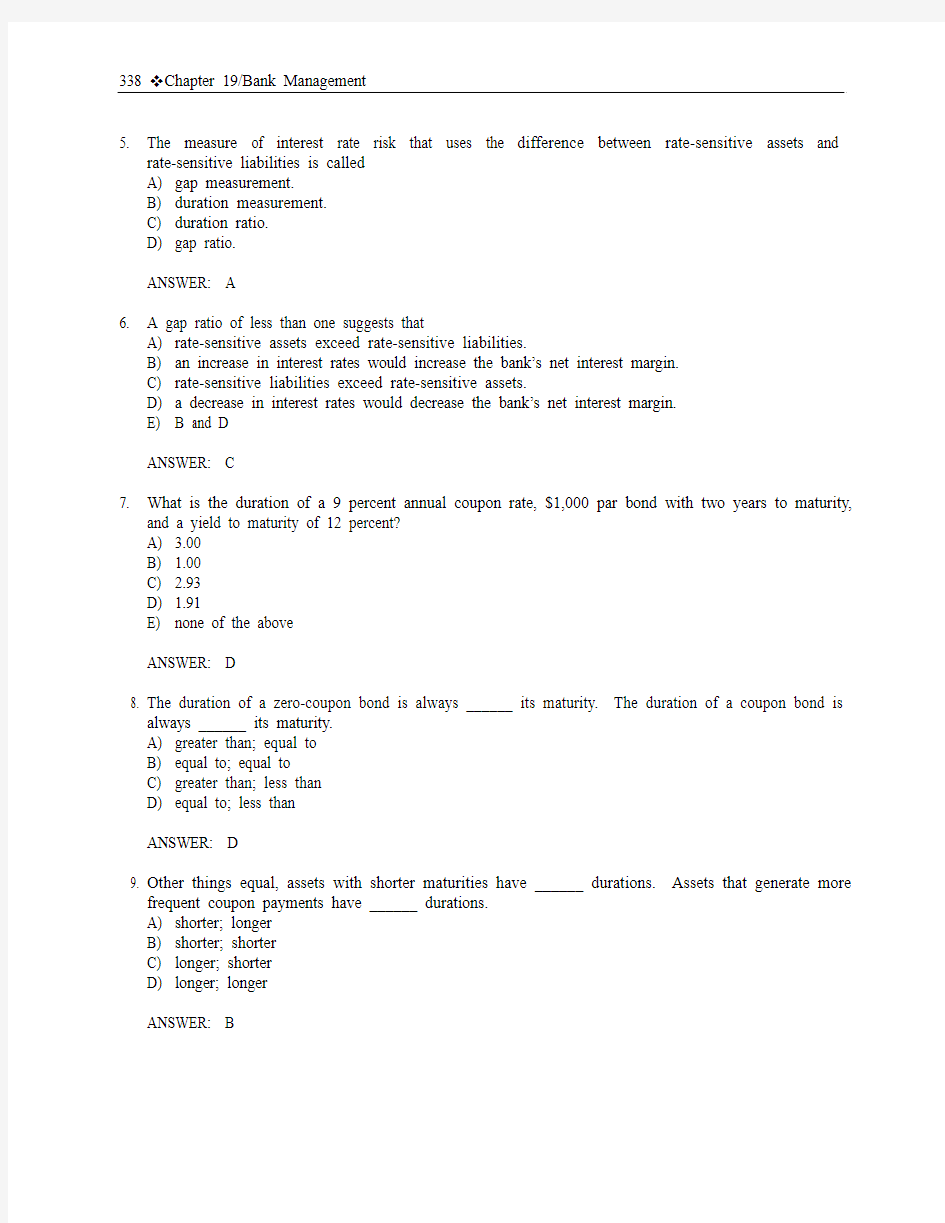tb19


Chapter 19
__________________________________
Bank Management
1. When cash outflows temporarily exceed cash inflows, banks are most likely to experience
A) higher dividend payments.
B) illiquidity.
C) a negative duration on its assets.
D) an excess of capital.
ANSWER: B
2. Banks can resolve cash deficiencies by
A) creating additional liabilities.
B) selling assets.
C) buying back common stock.
D) increasing dividend payouts.
E) A or B
ANSWER: E
3. If a bank that relies heavily on short-term deposits expects interest rates to consistently decrease over
time, it would allocate most of its loans with ______ rates if it desires to maximize its expected returns. It could reduce its exposure to interest rate risk by setting ______ rates on its loans.
A) fixed; fixed
B) variable; fixed
C) variable; variable
D) fixed; variable
ANSWER: D
4. During a period of rising interest rates, a bank’s net interest margin will likely ______ if its liabilities
are ______ its assets.
A) increase; more rate-sensitive than
B) decrease; more rate-sensitive than
C) increase; equally rate-sensitive as
D) decrease; equally rate-sensitive as
ANSWER: B
337
338 Chapter 19/Bank Management
5. The measure of interest rate risk that uses the difference between rate-sensitive assets and
rate-sensitive liabilities is called
A) gap measurement.
B) duration measurement.
C) duration ratio.
D) gap ratio.
ANSWER: A
6. A gap ratio of less than one suggests that
A) rate-sensitive assets exceed rate-sensitive liabilities.
B) an increase in interest rates wou ld increase the bank’s net interest margin.
C) rate-sensitive liabilities exceed rate-sensitive assets.
D) a decrease in interest rates would decrease the bank’s net interest margin.
E) B and D
ANSWER: C
7. What is the duration of a 9 percent annual coupon rate, $1,000 par bond with two years to maturity,
and a yield to maturity of 12 percent?
A) 3.00
B) 1.00
C) 2.93
D) 1.91
E) none of the above
ANSWER: D
8. The duration of a zero-coupon bond is always ______ its maturity. The duration of a coupon bond is
always ______ its maturity.
A) greater than; equal to
B) equal to; equal to
C) greater than; less than
D) equal to; less than
ANSWER: D
9. Other things equal, assets with shorter maturities have ______ durations. Assets that generate more
frequent coupon payments have ______ durations.
A) shorter; longer
B) shorter; shorter
C) longer; shorter
D) longer; longer
ANSWER: B
Chapter 19/Bank Management 339
10. If a bank attempts to reduce exposure to interest rate risk by replacing long-term marketable
securities with more floating-rate commercial loans, it is likely that the bank’s
A) default risk would decrease.
B) default risk would increase.
C) liquidity risk would increase.
D) liquidity risk would decrease.
E) B and C
ANSWER: E
11. Which of the following financial institutions would be most willing to swap variable-rate payments
for fixed-rate payments in order to reduce exposure to interest rate risk?
A) one whose assets and liabilities are equally interest-rate sensitive
B) one whose assets are more interest-rate sensitive than its liabilities
C) one whose liabilities are more interest-rate sensitive than its assets
D) one whose gap ratio is equal to 1.0
ANSWER: B
12. ROE is defined as
A) Net profit after taxes ? Equity
Assets . B) ?Assets
s af ter taxe prof it Net Equity. C) ?Assets s af ter taxe prof it Net Equity
Assets .
D) Net profit after taxes ? Assets
Equity .
ANSWER: C
13. The greater the ______, the greater the amount of assets per dollar’s worth of equity.
A) leverage measure
B) ratio of equity to debt
C) capital ratio
D) proportion of loans to securities in the asset portfolio
ANSWER: A
340 Chapter 19/Bank Management
14. A bank has a return on assets of 2 percent, $40 million in assets, and $4 million in equity. What is
the return on equity?
A) 10 percent
B) .2 percent
C) 2 percent
D) 20 percent
E) none of the above
ANSWER: D
15. A bank has the following asset and liability portfolios. What is the gap?
Rate-sensitive Amount Rate-sensitive Amount (in
assets millions) liabilities millions)
Floating-rate
loans $4,000 NOW accounts $1,750
Floating-rate
mortgages 1,000 MMDAs 4,500
Short-term
Treasury securities 1,500 Short-term CDs 1,000
6,500 7,250
A) $750 million
B) $750 million
C) 1.12
D) .896
E) none of the above
ANSWER: B
Chapter 19/Bank Management 341 16. A bank has the following asset and liability portfolios. What is the gap ratio?
Rate-sensitive Amount Rate-sensitive Amount in
assets in millions liabilities millions
Floating-rate
loans 4,000 NOW accounts 1,750
Floating-rate
mortgages 1,000 MMDAs 4,500
Short-term
Treasury securities 1,500 Short-term CDs 1,000
6,500 7,250
A) $750 million
B) $750 million
C) 1.12
D) .896
E) none of the above
ANSWER: D
17. If Bank A has a negative gap and Bank B has a positive gap. Which of the following is true?
A) Bank A is more favorably affected by rising interest rates
B) Bank B is more favorably affected by falling interest rates
C) Bank A is adversely affected by falling interest rates
D) none of the above
ANSWER: D
18. Which of the following is a measure for banks to assess their exposure to interest rate risk?
A) capital ratio
B) leverage measure
C) duration measurement
D) gap ratio
E) C and D
ANSWER: E
19. If a bank sells CD futures, it ______ of rising interest rates and ______ of declining interest rates on
its interest expenses.
A) reduces the potential adverse effect; reduces the potential favorable effect
B) increases the potential adverse effect; increases the potential favorable effect
C) decreases the potential adverse effect; increases the potential favorable effect
D) increases the potential adverse effect; decreases the potential favorable effect
ANSWER: A
342 Chapter 19/Bank Management
20. Which of the following loan portfolios are best diversified against default risk?
A) consumer loans to farmers and commercial loans to farm equipment dealers in a local area
B) commercial loans to the same industry
C) commercial loans to various retail stores in the same city
D) consumer and commercial loans to different industries in different cities
ANSWER: D
21. Banks can increase their liquidity position by restructuring their asset portfolio to contain less
______ and more ______.
A) excess reserves; Treasury bills
B) Treasury bonds; corporate bonds
C) loans; Treasury bills
D) none of the above
ANSWER: C
22. Banks would reduce their liquidity position by restructuring their asset portfolio to contain less
______ and more ______.
A) Treasury securities; excess reserves
B) loans; Treasury securities
C) corporate bonds; Treasury securities
D) none of the above
ANSWER: D
23. Banks can reduce their default risk by restructuring their asset portfolio to contain less ______ and
more ______.
A) Treasury bonds; corporate bonds
B) Treasury bonds; municipal bonds
C) Treasury bonds; commercial loans
D) none of the above
ANSWER: D
24. Banks can increase their potential interest revenues by restructuring their asset portfolio to contain
less ______ and more ______.
A) Treasury bonds; commercial loans
B) Treasury bonds; excess reserves
C) consumer loans; Treasury bills
D) none of the above
ANSWER: A
Chapter 19/Bank Management 343 25. If a bank desired to maximize its net interest margin, it would best achieve its goal by attempting to
obtain most of its funds through ______ and use most of its funds for ______ (assuming that all loans will be repaid).
A) traditional demand deposits; commercial loans
B) traditional demand deposits; consumer loans
C) NOW accounts; consumer loans
D) NOW accounts; commercial loans
ANSWER: B
26. A bank that holds a greater percentage of traditional demand deposits and loans will likely incur
______ non-interest expenses and have a ______ net interest margin than other banks of the same size (assuming that its loan losses are no higher than those at other banks).
A) greater; higher
B) greater; lower
C) less; higher
D) less; lower
ANSWER: A
27. A bank’s net interest margin is commonly defined as
A) interest revenues minus interest expenses.
B) (interest revenues minus interest expenses)/total assets.
C) (interest revenues minus interest expenses)/total liabilities.
D) (interest revenues minus interest expenses)/capital.
ANSWER: B
28. A common method for banks to reduce their default risk is to
A) specialize in loans to just one or a few particular industries in which they have expertise in
assessing creditworthiness.
B) specialize in loans of companies whose earnings patterns are quite similar over time.
C) A and B
D) none of the above
ANSWER: D
29. International diversification of loans can best reduce the bank’s overall default risk if
A) the countries where loans are given are clustered together in a single continent.
B) the countries where loans are given have economic cycles that do not move together over time.
C) A and B
D) none of the above
ANSWER: B
344 Chapter 19/Bank Management
30. The key reason that led to Penn Square’s failure was
A) fraud.
B) heavy concentration of loans in one industry.
C) excessive concentration in loans to government agencies (at low interest rates).
D) heavy foreign exchange losses.
ANSWER: B
31. Banks can reduce their required capital levels by
A) increasing their loans.
B) reducing their loans.
C) increasing their dividends.
D) obtaining more deposits.
ANSWER: B
32. Research on bank mergers has generally found that the acquiring bank’s stock price __________ at
the time of the acquisition.
A) rises moderately
B) rises substantially
C) declines or remains unchanged
D) All of the above occur with equal frequency.
ANSWER: C
33.Bank A has interest revenues of $4 million, interest expenses of $5 million, and assets totaling $20
million. Bank A’s net interest margin is
A)$1 million.
B)-$1 million.
C)–5 percent.
D) 5 percent.
ANSWER: C
34.____________ is not a method used to assess interest rate risk.
A)Ratio analysis
B)Gap analysis
C)Duration analysis
D)Regression analysis
ANSWER: A
Chapter 19/Bank Management 345 The following information refers to questions 35 and 36.
Durango Bank has $2 million in rate-sensitive liabilities and $3 million in rate sensitive assets.
35.Durango’s gap is ___________, and Durango is probably more concerned about a(n) ____________
in interest rates.
A)-$1 million; increase
B)-$1 million; decrease
C)$1 million; increase
D)$1 million; decrease
E)none of the above
ANSWER: D
36.Durango’s gap ratio is ____________.
A) 1.5
B)0.67
C)$1 million
E)none of the above
ANSWER: A
37._____________ is (are) least likely to be used as a method of reducing interest rate risk.
A)Maturity matching
B)Using floating-rate loans
C)Stock options
D)Using interest rate swaps
E)Using interest rate caps
ANSWER: C
38.Ringo Bank has a profit after taxes of $1.5 million, total assets of $50 million, and shareholder’s
equity of $30 million. Ringo’s return on equity (ROE) is _________ percent.
A) 1.8
B) 5.0
C) 3.0
D)none of the above
ANSWER: B
39.For a commercial bank, when the average duration of assets exceeds the average duration of
liabilities, the duration gap is
A)zero.
B)positive.
C)negative.
D)either B or C
ANSWER: B
